McIntyre accused by University of Queensland Prof of CRU break in
Watts Up With That from Andrew Bolt’s blog at the Herald Sun
Professor John Quiggin complains of smears by sceptics:
In recent years, science and scientific institutions have come under increasingly vociferous attack, with accusations of fraud, incompetence and even aspirations to world domination becoming commonplace. Scientists have been constrained in fighting back by the fact that they are ethically constrained to be honest, whereas their opponents lie without any compunction.
Ethically unconstrained, Professor John Quiggin smears a sceptic:
writing my previous post on the “Climategate” break-in to the University of East Anglia computer system, I remained unclear about who was actually responsible for the break-in theft of the emails, which were then selectively quoted to promote a bogus allegation of scientific fraud. Looking over the evidence that is now available, I think there is enough to point to Steven McIntyre as the person, along with the actual hacker or leaker, who bears primary moral responsibility for the crime.
So, to sum up, McIntyre organised the campaign which led to the creation of the file, obtained information from the CRU file system by means he declined to reveal, received the stolen emails shortly after the theft and made dishonest and defamatory use of the stolen information. Whether or not he was directly involved in the theft, or merely created the opportunity and benefited from the proceeds is impossible to determine, and essentially irrelevant.
OK professor, let’s see your evidence beyond this missive.
Somebody needs to educate Quiggin on the CRU ftp security blunder that was “the mole”. He doesn’t get it, and then proceeds to use that as “evidence” against McIntyre. It’s comical.
Here’s Professor Quiggin’s page at the University of Queensland.
------------------------
Climate Realists reports here: Sad news: George Monbiot, the high priest of the AGW cult, is feeling frustrated and depressed. He is oppressed by the realisation that, as the politicians phrase it, he is not getting his message across. And this blog, at least in a small way, bears some part of the responsibility. From his pontifical throne in the Vatican of global warming - The Guardian - he has issued an anathema. Quoting from a recent anti-AGW scam posting by me, he observes: “The attack on climate scientists is now widening to an all-out war on science.” Don’t get carried away, George. It is only an all-out war on bogus science, such as the global warming superstition you champion.
Paul Erlich, the master of exagerration and the epitome of a false prophet was given the platform by Nature and in his op ed he begins “The integrity of climate research has taken a very public battering in recent months. Scientists must now emphasize the science, while acknowledging that they are in a street fight. Climate scientists are on the defensive, knocked off balance by a re-energized community of global-warming deniers who, by dominating the media agenda, are sowing doubts about the fundamental science. Most researchers find themselves completely out of their league in this kind of battle because it’s only superficially about the science. The real goal is to stoke the angry fires of talk radio, cable news, the blogosphere and the like, all of which feed off of contrarian story lines and seldom make the time to assess facts and weigh evidence. Civility, honesty, fact and perspective are irrelevant.
---------------------
ABC News in Australia reports an Independent body to review UN climate panel
United Nations chief Ban Ki-Moon has announced a respected international body will conduct an independent review of UN climate science after a global warming report was found to have errors. But Mr Ban says the errors should not affect the conclusion that human activities are changing the climate and that greenhouse gas emissions should be cut urgently. “The threat posed by climate change is real, and nothing that has been alleged or revealed in the media recently alters the fundamental scientific consensus on climate change,” he said. The verdict is in before the jury is even assembled.
-------------------
Concerns raised over Institute of Physics climate submission to Parliament
A statement submitted by the Institute of Physics (IOP) to a parliamentary inquiry on climate change continues to draw criticism, with one senior physicist saying that it is “not worthy” of the organization. Others have complained that the statement appears to play into the hands of climate “sceptics”, as it criticizes scientists for withholding climate data when requested using the UK’s Freedom of Information Act. The IOP, which owns the company that publishes physicsworld.com, has responded by making it clear that it believes in man-made climate change and that its submission was criticizing instead the practices of the climate scientists at the centre of the inquiry. See the IOP page and comments here. See Watts Up With That coverage and comments here.
---------------------
And in this fairytale story from down under, AUSTRALIA’s two leading scientific agencies released a report today showing Australia has warmed significantly over the past 50 years, and stating categorically that “climate change is real”. The State of the Climate snapshot, drawn together by CSIRO and the Bureau of Meteorology partly in response to recent attacks on the science underpinning climate change, shows that Australia’s mean temperature has increased 0.7 degrees since 1960. No mention of the Pacific Decadal Oscillation, Great Pacific Climate Shift, the historic solar cycle or Warwick Hughes’ analysis of rural stations (with no UHI) all of which remain standing in contradiction of this.
--------------------------
At a briefing on Capitol Hill yesterday, Stanford University communication professor Jon Krosnick presented his ‘analysis’ estimating the impact of “ClimateGate” on public perceptions of climate change and of climate scientists. The briefing was co-sponsored by the high priests of the church of AGW in the The American Association for the Advancement of Science (AAAS), the American Meteorological Society (AMS), and the American Statistical Association (ASA). You missed nothing if you were not able to attend.
---------------------------
Ands finally in It’s Gettin’ Hot in Here: The Big Battle Over Climate Science in Discover Magazine, the king of the fraudsters, Michael Mann is grilled.
On Tom Nelson’s Blog
[Q] Who might have done the hacking?
[Michael Mann] It appears to have been extremely well orchestrated, a very professional job. There also appears to have been a well-organized PR campaign that was all ready to go at the time these e-mails were released. And that campaign, involving all sorts of organizations that have lobbied against climate change legislation, has led some people to conclude that this is connected to a larger campaign by special interests to attack the science of climate change, to prevent policy action from being taken to deal with the problem.
...
[Q] Judith Curry has been an outspoken critic of your work and of a lot of climate researchers in general.
[Mann] Did you ask Judith to turn over her e-mails from the past three years? Once she does that, then she’s in a position to judge other scientists. Until she does that, she is not in a position to be talking about other scientists. Glass houses. Look, I’ll just say this. I’ve received e-mails from Judith that she would not want to be made public.
...
[Q] What is the worst-case scenario? Are we talking about the risk of our demise as a species?
[Mann] That’s what scares me, yeah. yeah and maybe the other shoe to drop
---------------------------------
Cold Mid-Latitude Winter May have Implications on Hurricane Season
By Joseph D’Aleo, March 13, 2010
The blocking high pressure in the Polar Regions that dominated the winter and produced the record low arctic oscillation and a bitter winter in Mid-Latitudes of the Northern Hemisphere had effects further south that could have implications this hurricane season (below, enlarged here).

This pushed the subtropical high south of normal and made it weaker than normal. Winds were less than normal and cloudiness and precipitation were suppressed in the subtropics.
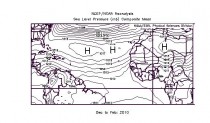
Mean winter pressure (above, enlarged here) - less than normal with center south of normal .
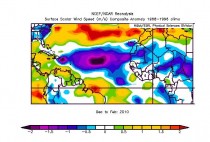
Mean winter surface winds (above, enlarged here) were weaker than normal through lower subtropics leading to less mixing of water and the development of a shallow pool of warm surface water and less upwelling of cold water off Africa from normal stronger northerly winds.
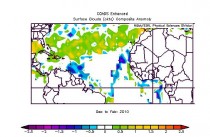
Also with the high pressure suppressed south of normal, cloudiness (above, enlarged here) was suppressed due to subsidence which further allowed more sunshine to warm the water (below, enlarged here).
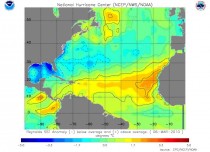
Also last season tropical activity was suppressed by El Nino. Tropical storms are a heat compensation mechanism, removing excess tropical ocean heat built up through the summer and peaking in the late summer and early fall and transporting that heat north in the form of sensible and latent heat in tropical storms. Less heat was removed last season than in an active season.
The big question is whether El Nino hangs on long enough to affect this season. Seasons after El Nino years tend to see a big rebound in activity (below, enlarged here).

Most ENSO models suggests it dies this summer. However westerly wind bursts continue to maintain a suppressed thermocline in the central Pacific with Kelvin waves that carry warm water east. Looks like at least one more El Nino bounce though with the warmest water more towards the central Pacific. El Ninos as you know and as we saw last summer, tend to reduce Atlantic activity and landfall threat by increasing the shear in the Atlantic basin.
Longer term, a negative PDO mode (temporarily weakened by El Nino), should ensure the next major ENSO event is La Nina perhaps later this year. See post here.
By Roy W. Spencer, Ph.D.
My post from yesterday showed a rather unexpected difference between the United States versus the rest of the world for the average urban heat island (UHI) temperature-population relationship. Updated results shown below have now reduced that discrepancy...but not removed it.
I have now included more station temperature and population data by removing my requirement that two neighboring temperature measurement stations must have similar fractions of water coverage (lakes, coastlines, etc.). The results (shown below, second panel) reveal less of a discrepancy between the U.S. and the rest of the world than in my previous post. The US now shows weak warming at the lowest population densities, rather than cooling as was presented yesterday.
Also, I adjusted the population bin boundaries used for averaging to provide more uniform numbers of station pairs per bin. This has reduced the differences between individual years (top panel), suggesting more robust results. It has also increased the overall UHI warming effect, with about 1.0 deg. C average warming at a population density of 100 persons per sq. km.
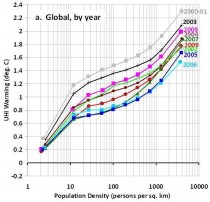
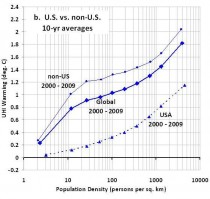
See enlarged for both here.
This is an update to my previous post describing a new technique for estimating the average amount of urban heat island (UHI) warming accompanying an increase in population density. The analysis is based upon 4x per day temperature observations in the NOAA International Surface Hourly (ISH) dataset, and on 1 km population density data for the year 2000.
John Christy has agreed to co-author a paper on this new technique, since he has some experience publishing in this area of research (UHI & land use change effects on thermometer data) than me. We have not yet decided what journal to submit to.
--------------------------
On the “march of the thermometers”
By Anthony Watts, Watts Up With That
I’ve been away from WUWT this weekend for recovery from a cold plus family time as we have visitors, so I’m just now getting back to regular posting. Recently on the web there has been a lot of activity and discussions around the issue of the dropping of climatic weather stations aka “the march of the thermometers” as Joe D’Aleo and I reported in this compendium report on issues with surface temperature records.
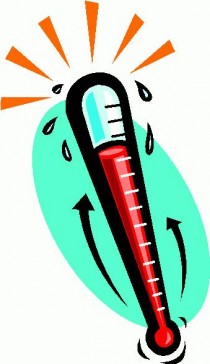
Most of the station dropout issue covered in that report is based on the hard work of E. M. Smith, aka “chiefio, who has been aggressively working through the data bias issues that develop when thermometers have been dropped from the Global Historical Climate Network. My contribution to the study of the dropout issue was essentially zero, as I focused on contributing what I’ve been studying for the past three years, the USHCN. USHCN has had a few station dropout issues, mostly due to closure, but nothing compared to the magnitude of what has happened in the GHCN.
That said, the GHCN station dropout Smith has been working on is a significant event, going from an inventory of 7000 stations worldwide to about 1000 now, and with lopsided spatial coverage of the globe. According to Smith, there’s also been an affinity for retaining airport stations over other kinds of stations. His count shows 92% of GHCN stations in the USA are sited at airports, with about 41% worldwide.
The dropout issue has been known for quite some time. In this post there is a video that WUWT contributor John Goetz made in March 2008 that shows the global station dropout issue over time. You might want to hit the pause button at time 1:06 to see what recent global inventory looks like.
The question that is being debated is how that dropout affects the outcome of absolutes, averages, and trends. Some say that while the data bias issues show up in absolutes and averaging, it doesn’t effect trends at all when anomaly methods are applied.
Over at Lucia’s Blackboard blog there have been a couple of posts on the issue that raise some questions on methods. I’d like to thank both Lucia Liljegren and Zeke Hausfather for exploring the issue in an “open source” way. All the methods and code used have been posted there at Lucia’s blog which enables a number of people to have a look at and replicate the issue independently. That’s good.
E.M Smith at “chiefio” has completed a very detailed response to the issues raised there and elsewhere. You can read his essay here. His essay is lengthy, I recommend giving yourself more than a few minutes to take it all in. Joe D’Aleo and I will have more to say on this issue also. See post here.
Icecap Note: See also this post here.
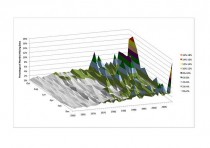
See the number of missing months increase (enlarged here) with a strong bias towards the colder months.
See also this one on Alert station in Canada and GISS.
------------------------
Follow the Money
Enough is enough.
It’s about time that someone once and for all puts the lie to the recurrent charges that the AGW skeptical community is supported by “Big Oil”, or is populated by “flat-earthers”, or by those who in the past have been complicit with “the tobacco lobby”. These transparently pejorative statements are frequent inclusions in postings and commentary by AGW proponents , sometimes by less committed followers of the AGW controversy and even by some posters who are intellectually inclined to side with the skeptics. There are rarely any substantiating statements to support these allegations which in the absence of any formal repudiation by those so categorized, take on a life of their own like so many urban myths that populate the blogosphere.
The facts are that quite the opposite is the case. For example, let’s take “Big Oil”. BP has contributed over $500 Million to UC Berkeley, one of the Bay Area’s centers of AGW support, for its Energy Biosciences Institute.
Stanford University has received $225 Million from ExxonMobil, Toyota and Schlumberger for its Global Climate and Energy Project. That money will be combined with a $50 Million donation from alumnus Jay Precourt whose career as an oil engineer included such companies as Hamilton Oil and Tejas Gas Corp. The new entity will be named the Precourt Center for Energy Efficiency. See here.
Compare these numbers with a total of ~$6.4 Million over a 4-year period between 2002-2005 provided to non-academic and presumably more conservative think tanks by ExxonMobile according to data acquired by EDF (hardly an unbiased source). See here.
As for individuals active in the promotion of AGW, Susan Solomon, a Phd from Stanford and a lead author of the 2007 IPC Report was a recipient of the 2004 Blue Planet Prize, a 50 Million Yen (~$460,000) cash award from the Asahi Glass Foundation , see here. Other high profile figures such as James Hansen and Michael Mann have received six-figure amounts from organizations such as the Theresa Heinz Foundation and the Dan David Foundation. It seems as though being a staunch proponent of AGW is a very rewarding position to have.
These are just a fractional example of the money that has flowed from the private sector to individuals and academic institutions friendly to the notion of anthropogenic influences on the environment. Over the past 10 years Government funding to such organizations has been conservatively estimated at well over $50 Billion.
Compare these enormous sums of money with the amounts that are received by prominent and well qualified members of the skeptical community. I know from personal association that external funding for such sites as WUWT and icecap is in the low five figures and comes almost exclusively from individual donations from those who access these sites. It would seem that the thinly veiled assertions from those expressing an alarmist position that people who adopt a more skeptical attitude are somehow insincere and must be doing it for the money. Since this is patently untrue, I submit that such accusations are more likely to be evidence of projection than of fiscal reality and they are more designed to obfuscate than enlighten the debate.
See more here.
By Steve Goddard Guest Post on Watts Up With That

Snow blankets New York City. Photo: Del Mundo, New York Daily News
Now that we have reached the end of the meteorological winter (December-February,) Rutgers University Global Snow Lab numbers (1967-2010) show that the just completed decade (2001-2010) had the snowiest Northern Hemisphere winters on record. The just completed winter was also the second snowiest on record, exceeded only by 1978. Average winter snow extent during the past decade was greater than 45,500,000 km2, beating out the 1960s by about 70,000 km2, and beating out the 1990s by nearly 1,000,000 km2. The bar chart below (enlarged here) shows average winter snow extent for each decade going back to the late 1960s.
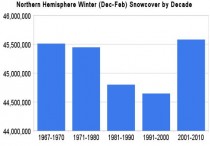
Here are a few interesting facts.
Average winter snow extent has increased since the 1990s, by nearly the area of Texas and California combined.
Three of the four snowiest winters in the Rutgers record occurred during the last decade - the top four winters are (in order) 1978, 2010, 2008, 2003. The third week of February, 2010 had the second highest weekly extent (52,170,000 m2) out of the 2,229 week record.
The bar graph below (enlarged here) shows winter data for each year in the Rutgers database, color coded by decade. The yellow line shows the mean winter snow extent through the period. Note that the past decade only had two winters below 45 million km2. The 1990s had seven winters below the 45 million km2, the 1980s had five winters below 45 million km2, and the 1970s had four winters below 45 million km2. This indicates that the past decade not only had the most snowfall, but it also had the most consistently high snowfall, year over year.
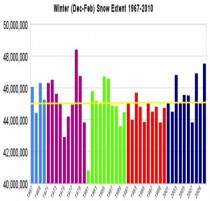
It appears that AGW claims of the demise of snowfall have been exaggerated. And so far things are not looking very good for the climate model predictions of declining snowfall in the 21st century.
Many regions of the Northern Hemisphere have seen record snowfall this winter, including Washington D.C, Moscow, China, and Korea. Dr. Hansen’s office at Columbia University has seen record snowfall, and Al Gore has ineptly described the record snow: “Just as it’s important not to miss the forest for the trees, neither should we miss the climate for the snowstorm,”
A decade long record across the entire Northern Hemisphere is not appropriately described as a “snowstorm.” See post and comments here.
‘Snowball Earth’: Glaciers, ice packs once met at EquatorBy Lewis Page, The Register
Macdonald says that glaciers on land at the Equator means solid pack ice at sea in the tropics, too.
“Climate modeling has long predicted that if sea ice were ever to develop within 30 degrees latitude of the equator, the whole ocean would rapidly freeze over,” he says. “So our result implies quite strongly that ice would have been found at all latitudes during the Sturtian glaciation.”

Enlarged here.
Even on Snowball Earth, however, it’s thought that there must have been “refugia” where liquid surface water and at least occasional sunlight remained, as proto-animal life above the bacterial level is believed to have arisen and survived at around the time of the first, Sturtian snowballing. Macdonald considers that the big freeze may actually have stimulated early, primitive life to get its act together and begin the long process which has led to the present-day biosphere.
“The fossil record suggests that all of the major eukaryotic [other than microbial] groups, with the possible exception of animals, existed before the Sturtian glaciation,” says the prof. “The questions that arise from this are: If a snowball Earth existed, how did these eukaryotes survive? Did the Sturtian snowball Earth stimulate evolution and the origin of animals?”
“From an evolutionary perspective,” he adds, “it’s not always a bad thing for life on Earth to face severe stress.”
Macdonald and his colleagues aren’t sure what triggered the Sturtian snowball effect, but note that a lot of lava came to the earth’s surface at around that point, suggesting that the big chill could have been kicked off by volcanic dust darkening the skies.
The Harvard team publish their results this week in hefty boffinry mag Science.
Global warming may be normal at this point in glacial cycle
By Lewis Page, The Register
German and Russian scientists say that it is normal for an interglacial period like the one just ending to finish with one or more brief - in geological terms - spells of warming before the glaciers return.
According to boffins based at the Helmholtz-Zentrum für Umweltforschung (UFZ) and at the Russian Academy of Sciences, in the Earth’s history thus far there have been eras where the glaciers covered much of Europe, lasting about 100,000 years. These are separated by warmer interglacial periods lasting around 10,000 years. We are currently at the end of an interglacial era called the Holocene.
The scientists, looking into the last interglacial period - the Eemian - which ended around 115,000 years ago, say they have found that that it ended with “significant climate fluctuations” before the rule of the glaciers returned.
The scientists got their results by examining ancient lake sediments exposed by modern open-cast mining in Russia and Germany. They believe that the end of the Eemian interglacial epoch saw “possibly at least two” warming events, according to a statement issued by the UFZ.
“The observed instability with the proven occurrence of short warming events during the transition from the last interglacial to the last glacial epoch could be, when viewed carefully, a general, naturally occurring characteristic of such transition phases,” concludes UFZ boffin Dr Tatjana Boettger.
Boettger and her fellow researchers say that the Eemian ice-free period wound up with sudden - in these terms - warming spells and serious changes in vegetation. Then the glaciers surged south, at their high tide 21,000 years ago reaching as far as Berlin.
This Weichselian Glacial era ended around 15,000 years ago, leading to the conditions which have been seen for all of human history with the ice caps confined to the polar regions. The UFZ says that this Holocene era reached its “highest point so far around 6000 years ago” and that we might now expect to see sudden warmings and changes as at the end of the Eemian - followed by a slow descent into another freezing glacial era.
“Detailed studies of these phenomena are important for understanding the current controversial discussed climate trend so that we can assess the human contribution to climate change with more certainty,” comments Dr Frank W Junge of the Sächsischen Akademie der Wissenschaften (Saxon Academy of Sciences, SAW) in Leipzig.
The profs’ paper Instability of climate and vegetation dynamics in Central and Eastern Europe during the final stage of the Last Interglacial (Eemian, Mikulino) and Early Glaciation can be read here (subscriber link).
Coldest Winter In 30 Years and Coldest February Since 1979
By Meteorologist Bobby Boyd, National Weather Service, Nashville, Tennessee
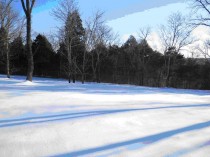
Photo Credit: Bobby Boyd
It’s been unusually cold this winter across Middle Tennessee (coldest in 30 years) with all three winter months below normal in temperature at Nashville for the first time since the winter of 1977-1978. The temperature this winter (Dec, Jan, Feb) averaged 35.6 degrees making the meteorological winter of 2009-2010 the 11th coldest on record and the coldest since the winter of 1978-1979. The temperature this winter in Nashville averaged 4.0 degrees below normal. The coldest temperature this winter in Nashville was 8 degrees on January 10, 2010.
The months of December, January and February are considered the meteorological winter by most meteorologists and climatologists as opposed to the astronomical winter which begins with the winter solstice and ends with the vernal equinox.
Rainfall totaled 10.89 inches for the winter months which is 1.31 inches below normal. Snowfall for the winter months totaled 7.1 inches. While only a trace of snow fell in December 2009, January totaled 4.8 inches and February 2.3 inches. This has been the snowiest winter in the Nashville area since the winter of 2002-2003 when 15.1 inches fell. Average winter snowfall is 9.1 inches for the Nashville area.
Coldest Winters In Nashville
1. 1977-1978
2. 1962-1963
3. 1976-1977
4. 1917-1918
5. 1935-1936
6. 1904-1905
7. 1901-1902
8. 1885-1886
9. 1978-1979
10. 1963-1964
11. 2009-2010
12. 1894-1895
February 2010 ended 6.9 degrees below normal making it the 12th coldest February on record in Nashville and the coldest since 1979. The temperature reached 50 degrees only on 4 days during the month of February. This is the fewest 50 degree days since February 1978 when 50 degrees was reached only on 1 day during the month, which is the fewest ever in the month of February. The temperature reached 60 degrees only on 2 days in February of 2010. This is the fewest 60 degree days in February since 1978 when Nashville failed to reach the 60 degree mark for the only time in the month of February.
Rainfall during the month of February totaled 2.77 inches which was 0.92 inches below normal. Snowfall totaled 2.3 inches in February. Average snowfall in February is 3.4 inches.
Coldest Februarys on record.
1. 1978
2. 1899
3. 1895
4. 1905
5. 1958
6. 1902
7. 1947
8. 1968
9. 1885
10. 1979
11. 1963
12. 2010
Read more here.
-------------------
The coldest winter in three decades in South Florida here.
A colder-than-normal February wrapped up the coldest winter since the early 1980s over south Florida. Almost all main weather reporting sites recorded the coldest December-February average temperature since 1981, except for Miami International Airport which recorded its coldest average winter temperature since 1986. December to February temperatures ended up about 2 to 3 degrees below normal, which is remarkable considering that December was 2 to 3 degrees above normal.
These values resulted in the following all-time recorded rankings: Miami Beach recorded its 2nd coldest winter on record; Naples recorded its 6th coldest winter on record; Moore Haven its 8th coldest and West Palm Beach its 10th coldest winter on record.
The extended periods of cold temperatures in January and February resulted in average temperatures during that two-month period of 4 to 5 degrees below normal. This resulted in all four main climate stations recording among the top 10 coldest January-February temperatures on record. Miami Beach set a record for its all-time coldest January-February on record (previous record set in 1958). In West Palm Beach, it was the 2nd coldest January-February on record; Naples recorded its 3rd coldest January-February, Moore Haven its 3rd coldest, Fort Lauderdale its 8th coldest and Miami its 10th coldest January-February average temperature on record. Only in the winters of 1940, 1958, 1977 and 1981 did January-February average temperatures come close to what was observed in 2010. The coldest period observed this winter was between January 2nd and January 13th when south Florida experienced one of its coldest 12-day periods on record (read more about this exceptional cold episode here).
---------------------
First Tornado Free February in at Least 60 Years
See also here where this is the first February without a tornado for the United States in at least 60 years.
February typically has 22 tornadoes on average, based on reports dating back to 1950 from the SPC. “Despite it being an El Nino year, which would normally mean severe weather in the South, the jet stream has been depressing cold air very far south and it has combined with cooler-than-normal Gulf of Mexico water temperatures,” Margusity said. “These have led to the suppression of severe weather in February.”
However, this would not be the first tornado-free month on record. According to the SPC, only five months since 1950 have failed to turn in a tornado report: October 1952, December 1963, November 1976, January 1986 and January 2003. Story thanks to AccuWeather.com’s Jon Auciello.
Pajamas Media
The data underlying the famous “hockey stick” global warming graph has finally been found after having earlier been misplaced by leading climate researchers. The newly recovered data confirms the accuracy of the abrupt upward turn in readings characteristic of the “hockey stick” shape found in many global warming projections.
Up until now, however, the data on which the controversial graph had been based was presumed to be lost, so it was not known exactly which aspects of global warming the chart illustrated. Now that the data has been recovered, scientists can state with complete certainty that this updated chart accurately chronicles the past and future trajectory of the global warming crisis.
View the full-size graph by clicking HERE or on the small version shown below:
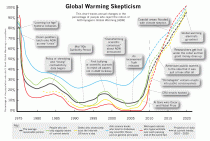
-------------------------
Snowicane - Major Storm Clobbers Northeast
By Joseph D’Aleo
A major nor’easter with hurricane force winds, mountainous snowfalls, flooding rains has slammed the northeast leaving at least 700,000 homes and businesses without electricity. Power failures were so bad in New Hampshire that even the state Emergency Operations Center was operating on a generator. Meanwhile in this upside down storm, it was rain and hurricane force winds in eastern New England with a wind gust of 91 mph at Isle of Shoals near Portsmouth, New Hamsphire and 94 mph at Cape Elizabeth, ME, well above hurricane force of 74 mph. Gusts hit 60 mph or more from New York’s Long Island to Massachusetts.
Public Service of New Hampshire, the state’s largest utility, reported power cut to at least 237,000 homes and businesses and said it would take days before everyone’s lights flickered back on. New York had more than 220,000 customers without power, mostly in the Hudson Valley north of New York City. Maine reported 130,000, Massachusetts 100,000, Vermont 25,000 and New Jersey 11,000.
New York City’s Central Park has had 20.9 inches as of 7 pm Friday, the fourth greatest for any storm in New York City since 1869. It is a new record monthly snow FOR ANY MONTH with 36.9 inches breaking the old record of 30.5 in March 1896.

But up in the Catskills, they hit the jackpot with a 5-day total of 84 inches at Hunter Mountain and 60 inches at Windham. Here is this Friday’s newsletter email from Hunter Mountain.
Good morning from Hunter Mountain!!
We wanted to let you know that we’ve received 60” of snow (they added at least 5 during Friday) in the last 3 days… and we wanted to invite you to come up and shoot some photos, film, or just to see this crazy snow for yourself!
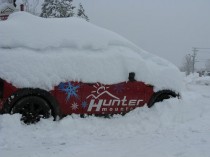
We watched the weather report this morning, and they reported a mere 30” total in Greene County—it made us laugh. There’s more than 5 feet of snow in Hunter, with roadside snowbanks 10-12 feet high.
It’s still snowing here, albeit lightly… but we’re expected to get another 4-8” today as the storm winds its way back and hits us again!
If you’d like to come up, or if you’d like more info on the “Snowicane” of 2010, hit me up! We can certainly make arrangements for you. This is epic snow that has not been present in the area since the 30’s and 50’s—come up and take a bit ol’ bite of snowstorm history here, folks! We’ve had hundreds of die-hard skiers and riders here to ski and ride through this storm!
We hope you’ll consider taking a ride up here… the snow has calmed a bit, the roads are in good shape. For up-to-date info on our operations, visit the Hunterblog. Check our Photo Gallery for some photos from the past few days… our webcams are running as well (we’re working on digging out the summit cam...). As we’ve been telling our fans & followers… come get some!!
See the Bloomberg story on the new monthly record here.
From New York to northern New England Mountains, near or more than 4 feet of snow fell. Sunday, River, Sugarloaf in ME, Stove in VT over 50 inches so far. Another foot or more coming tomorrow in a wrap around storm.
--------------------------
Depth of two-day snowfall remains blanketed in mystery
By By Frank D. Roylance, Baltimore Sun
The blizzard that heaped more than 2 feet of snow on Baltimore on Feb. 5 and 6 was probably the deepest two-day snowfall on record. But we might never be sure how deep it was.
A contractor working for the Federal Aviation Administration at BWI Thurgood Marshall Airport, paid to measure the snow for the aviation industry’s needs, did not follow a separate protocol required by the National Weather Service and the National Climatic Data Center for valid climate data.
So while the contractor measured 28.8 inches of snow during that storm, the National Weather Service has thrown out the reading. Instead, climatologists will rank the storm as “only” 24.8 inches - a number that almost surely understates the “true” total.
Worse, for climatologists, it now appears the weather service’s rules for snow data had been ignored for years at BWI, throwing a cloud over the validity of snow totals as far back as 1998, when the FAA took the job over from the weather service.
Only BWI’s data are known to be affected, but the problem could be more widespread. That possibility has caught the attention of top officials at the FAA.
“We plan to meet with the National Weather Service next week to begin a discussion on making sure that we’re all on the same page in terms of measuring snow accumulations at our airports,” FAA spokesman Jim Peters said. “There will be a national discussion.”
In the meantime, the weather service’s Baltimore- Washington Forecast Office in Sterling, Va., is preparing to convene a committee of climatologists and other experts to review Baltimore’s snowfall records from the 2010 and 2003 storms, and perhaps back to 1998.
“I feel very strongly about historical records and getting the climate data correct,” said James E. Lee, the meteorologist-in-charge at Sterling. “Obviously, with the increased media attention and political attention to climate, it is really up to NOAA [the National Oceanic and Atmospheric Administration, of which the National Weather Service is an agency] to make sure ... the climate record is a genuine one, and consistent to the best of our ability.”
The problem at BWI came to light Feb. 6, as snow accumulations reported at the airport passed 26 inches. They seemed poised to break the record set in February 2003 - the storm listed on Sterling’s Web site as Baltimore’s biggest.
But when reporters called asking about a new record, Lee said that because of measurement errors by an FAA contractor at BWI, the two-day storm total would be pegged at “only” 24.8 inches. He had discarded a 28.8-inch measurement from BWI because it was the sum of hourly measurements throughout the storm - a method invalid for climatological data.
Even at 24.8 inches, Lee said, the storm total beat the previous two-day record of 24.4 inches, set at BWI during two days of the four-day 2003 event. “I’m convinced that was the most amount of snow Baltimore has seen [from a two-day storm] in recorded history.”
But Lee had to use the most conservative reading from the airport - a “snow depth” measurement of the total on the ground when the storm ended, after hours of compaction.
The FAA requires its observers to take hourly snow measurements and wipe the boards clean after each hour, adding the totals as they go. That provides pilots with better real-time information about changing conditions. But it virtually eliminates compaction and so inflates accumulation. Climatologists require measurements every six hours, striking a balance between the hourly and snow depth readings. Some airports maintain separate snow boards for the different protocols. But not BWI.
Richard Carlson, vice president of Pacific Weather Inc., said his company has experienced weather observers at 20 U.S. airports, including eight at BWI. Pacific has held the contract there since 2008.
“We follow the FAA manual ... and that is the guide book on how these meteorological observations are to be taken,” Carlson said. “We had heard about the six-hour measuring thing, but ... if you have high winds at all, this really is not going to work.”
So when Lee questioned the snow data from BWI on Feb. 6, Carlson said, “we informed them [Lee] that we have different criteria, a different manual we are following.” He says the company’s predecessor at BWI also followed FAA rules.
Lee “kept harping back to the six-hour measurement thing,” Carlson said. “That’s meant for climatological purposes, and what we’re doing is operational,” serving the needs of the airport. “He wasn’t real happy.”
Lee wasn’t happy, but there was little he could do. “It’s interesting to have the responsibility for quality control but not the authority to tell the [FAA] contractor what to do,” Lee said.
“In future inspections, this will be raised ... prior to the start of the winter season, to ensure the six-hour swipe is going to be adhered to,” he said.

Shawn Durkin, weather station manager who has worked for Pacific Weather Inc. for 16 years, stands on the rooftop location at BWI where Pacific Weather takes its snow measurements, using a snow board, mounted on the bench to his left, and an 8-inch rain gauge, at right
Read full story here.
Dr. Richard Lindzen’s Talk at FermilabBy The Hockey Schtick
VIEWS ON CLIMATE CHANGE & CLIMATEGATE
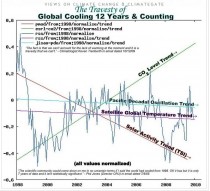
Enlarged here.

Richard Lindzen PhD, the Alfred P. Sloan Professor of Meteorology in the Department of Earth, Atmospheric, and Planetary Sciences at the Massachusetts Institute of Technology, was recently invited to give a talk entitled “The Peculiar Issue of Global Warming” at Fermilab 2/10/10 which you can watch in its entirety with slides here. Dr. Lindzen calmly eviscerates the theory of catastrophic anthropogenic global warming (CAGW) and the IPCC “consensus”. Highly recommended.
Below are 3 slides from the presentation, the first noting that the theory of intelligent design sounds rigorous by comparison to the theory of anthropogenic global warming, the second noting that 3 pro-CAGW publications have already acknowledged that temperature data has contradicted the man-made attribution assumption (primarily CO2), which is the inherent assumption of the IPCC models, and the third noting that the fundamental assumption of CAGW that there is positive feedback by water vapor due to CO2 is “likely wrong”.
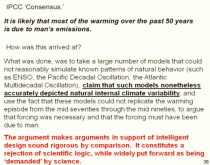
Enlarged here.

Enlarged here.

Enlarged here.
See full blog post here.
By Edward Long, American Thinker
Our study of data-massaging by the U.S. government agency charged with collecting temperature information raises uncomfortable questions.
We have been repeatedly told (perhaps “lectured” is a better word) the past twenty years that global warming is occurring. With Climategate and subsequent confessions and bailouts by scientists at the CRU, Penn State, Arizona State, IPCC, et al., we are learning that little to none of the factual content in their “peer reviewed” articles is true. The Medieval Warming Period did occur, and it was warmer than currently; the oceans are not going to flood the plains; and the Arctic Ocean may not be turning into a summer water park. Of course, the mainstream media, especially in the United States, has reported little of this news, and President Obama appears not to be well-informed. But now the global warming story grows more interesting because here in America, we may have our own little “gate.” I will call it ATG, for “American Temperaturegate.”
NOAA’s National Climatic Data Center (NCDC) informs us, based on their “Adjusted Data” for the period from the last decade of the 19th century to 2006, that the temperature for the contiguous U.S. has increased at a rate of 0.69C/century. Click here. NCDC arrives at this conclusion by massaging raw data from a set of meteorological stations located in the contiguous U.S. which they selected on the basis of a 2.5-degree latitude- and 3.5-degree-longitude grid. For more on this, click here and here. The most-asked question, most recently by D’Aleo and Watts, is whether the NCDC’s reported increase is correct. Perhaps the value is due to a dominant use (over-selection) of stations in urban locations or because of other issues, such as leaving out stations at higher altitudes for the more recent history and retaining them for the more distant past.
Here, one aspect is considered—that of the Urban Heat Island Effect, which is tagged as UHIE.
We selected two sets of meteorological stations (48 each, with one station per each of the lower 48 states) from the NCDC master list. The stations in one set were at rural locations—a rural set. The stations in the other set were at urban locations—an urban set. The NCDC latitude and longitude station coordinates were used to “fly over” the locations on a computer, using a GPS map application to confirm the rural and urban characteristics. For each of the 96 stations, the NCDC’s raw and adjusted temperature data were entered into a spreadsheet application and studied. The “raw” data are the annual average temperatures of the measured data. The “adjusted” data are the annual average temperatures the NCDC derived from the raw data by making a set of “corrective” assumptions for time of day, type of instrument, etc. and guessing the temperature at stations for missing data based on temperatures of other stations at the same latitude and/or region. For a more in-depth understanding of the NCDC protocols for converting raw data to adjusted data, click here. A summary of the findings is in the following table. The values in the table (below, enlarged here)show that the NCDC’s rate of increase of temperature, 0.69C/century, is based on an over-selection of stations with urban locations.

The values in the table highlight four important considerations:
1) The rate of increase for rural locations, based on as-measured (raw) values, is small (if not, in effect, zero) at 0.11 C/century.
2) There is definitely a UHIE in that the urban raw data has a rate of increase of 0.72C/century. This tells us that man has caused warming in urban locations. This finding should not surprise anyone. On the other hand, because the rural value is 15% of the urban value, the UHIE has not caused warming in the rural locations, and it certainly has not caused a global sense of warming other than the aspect that the urban location values when averaged with the rural values produce an average increase which is larger than that of the rural alone.
3) The rural + urban value for the adjusted data, 0.65C/century, is still less than the 0.69C/century published by the NCDC. Thus, likely, there are more urban than rural sites used by the NCDC.
4) And this is the “Temperaturegate” aspect: The NCDC’s massaging—they call it “adjusting”—has resulted in an increase in the rural values, from a raw value of 0.11C/century to an adjusted value of 0.58C/century, and no change in the urban values. That is, the NCDC’s treatment has forced the rural value to look more like that of the urban. This is the exact opposite of any rational consideration, given the growth of the sizes of and activities within urban locations, unless deception is the goal.
The criticism this makes of the NCDC’s treatment of historical data for the contiguous U.S. is the same as a recent Russian paper made of the HadCRUT treatment of historical temperature data for Russia. For a thumbnail of the points made in that paper, click here.
See full Temperaturegate story here.
Edward R. Long holds a Ph.D. in physics. He is a retired NASA scientist who is a consultant on radiation physics for space flight and on energy/climate in the Commonwealth of Virginia.
See full paper on SPPI here and an excellent Watts Up With That blog and discussion with comments here.
By Al Gore
With all the climate deniers spreading lies about the climate crisis in the media, it’s vital we arm ourselves with the facts. Thankfully, Repower America put together a great fact sheet explaining the relationship between the climate crisis and extreme weather:
“Fact: Climate change causes more frequent and severe snowstorms
Record snowstorms need two things: temperatures below freezing, and very high humidity. On a planet warmer by a few degrees on average, the Northeast US will still have plenty of days below freezing; the big difference will be warmer seas producing higher levels of moisture in the air - and therefore more severe cold-season storms.”
“Fact: We can expect more extreme weather
Scientists tell us that climate change has already led to more extreme weather in the United States and we can expect stronger hurricanes, more wildfires, heatwaves and droughts, to name a few.”
“Fact: The world is warming at a quickening pace
Weather in one region over days or months should not be confused with climate or the patterns of weather over decades and centuries. And the science is clear here: the last decade was the hottest on record. And to put this year’s weather in perspective, January was warmer than average for the continental United States”
As usual the Goracle is clueless. He is wrong on all three points. For examples, this winter featured snowmagedden for the Mid-Atlantic states. The longest duration cold ever in Florida and the southeast including snowflakes in Miami and Naples and damage to the citrus. Yes with the January thaw which is strongest and most reliable in the coldest winters, the average for the US for the month was a little above, much of the central and southeast was much below normal. And here is what the winter since December 1 looks like so far.
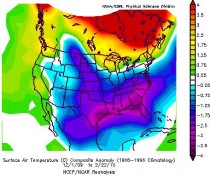
You say one winter doesn’t count and that I am cherry picking. Remember the fact sheet picked one number one month. December was the 14th coldest of 115 years for the US and February will rank similarly. And we have had 3 cold winters in a row. The northern cold and records snows of the last two years were blamed on La Nina and we were promised global warming would return with a vengeance when El Nino came back. Well guess what? It did this past summer and was El Nino was moderate this winter and yet it was colder and even snowier, even in places like the Dakotas and Iowa where El Ninos are typically warm and snowless. Oh and as for the red in Canada that is the result of the 5 standard deviation negative AO which produces blocking high pressure. Temperatures are much warmer than normal in the blocking areas (0 to 10 below instead of 10 to 20 below F) but still cold. Fill in your own expletives.
BTW, thanks to Craig Woods This is thre breakdown of records to date month-by-month this winter. Even with the Urban Heat Island affect, this winter in the United States has seen many more (3X) record low minimums than record high maximum temperatures. (Hat Tip Boris Konon, WSI). Here are the numbers:
December
Record high maximums 264
Record low minimums 1,086
January
Record high maximums 342
Record low minimums 901
February (through 2/24)
Record high maximums 80
Record low minimums 240
-------------------------
Bill O’Reilly hosts Bill Nye The Science Guy and AccuWeather’s Joe Bastardi in Fox News Debate
By Anthony Watts, Watts up With That
Heh, this is entertaining.
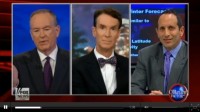
While Bill Nye argues for “in whose best interest is denial?” and brings up the ridiculous CO2 on Venus argument, Joe Bastardi runs circles around him with technical graphs and explanations on forcing factors and their magnitudes.
Warmists scream “weather is not climate!”. We need to shout back “Venus is not Earth!” since the Venusian atmosphere is entirely different in compositions and forcings, and we understand it far less than Earth’s. Icecap note: as commenters said also 26 million miles closer to the sun and days 150 of our days long and has an atmosphere that is denser and deeper with surface pressures 90 times earth producing compressional warming. In the Venusian atmosphere at the same pressure as earth’s, temperatures are comprable to earth. Of course Nye did not mention Mars, where even though its atmosphere is mainly C02, the air is colder because the atmosphere is thin and pressures lower and of course Mars is farther away. See comments for much more.
Meanwhile, Bill O"Reilly seems more concerned about making his commercial break on time than saving the planet.
Nye needs a better argument, as Fox News viewers can see past the appeal to emotion. Bastardi while far more technically competent than Nye, needs to focus on explaining a bit about natural cycles, since few viewers would know what the “PDO” is.
A caveat for both men, doing live TV debate by the seat of your pants is tough. You can’t see each other, and you are communicating via earpiece audio. Live TV is never easy, live via satellite interlinks is even tougher.
Watch the segment => here.
Icecap Note: Agreed TV interviews are no walk in the park. When on tape you have no control over what they use. When you are live, often, as Anthony said, you are unable to see the other parties or the interviewer (I did one interview for a major cable network at a local station from what was no more than a closet with a camera and lighting and no monitor). Often the host keeps interrupting or allows your opponent to go on a monologue (especially with the college professors) with too little chance for you to reply. Sometimes when they give you a few questions to prepare for, they come in from left field with another often oddball question frustrating you because you had in your mind exactly how you were going to reply). Nye proved hand held graphics usually don’t work. The only one that did was the SPPI temperature plot which showed the cooling for a blend of the station data sets and satellite data sets since 2001. Nye followed that with an unintelligible statement to the effect if you leave out 1998, you get a warming. Well I thought 1998 was before 2001. How foolish of me.
---------------------------------
A worldwide fervor over climate change orthodoxy
By Christopher Essex, Toronto Sun
Can you hear me? You’ve been incognizant, but it’s over and you’re going to be OK. Take deep breaths and relax until your vision clears. The world is not going to end because of climate change, at least not in the near future. You are a most fortunate individual. You have been a participant in the biggest inter-dimensional cross rip since the Tunguska blast of 1909! No wait, that’s Ghostbusters.
Let me put it differently: There has never been anything quite like this - ever. The entire world has been embroiled in a persistent, free-floating global fervor (and a really nasty one, too) allegedly based on fervor-less, dispassionate science.
Recently, there was a huge explosion in the climate change orthodoxy factory that was set off by objective evidence we have been deceived and manipulated. The evidence was the leaked e-mails of the University of East Anglia’s Climate Research Unit (CRU), which are now subject to several official investigations, forcing the head of the CRU to step aside. The e-mails tell a lurid tale of unbecoming, unwarranted, organized and fierce hostility to skeptical climatic researchers, as well as data tampering, anti-scientific secrecy, manipulations of scientific journals, and distortions of peer review that make George Orwell look like a prophet.
This could be dismissed as an isolated case if the CRU were some marginal backwater. But what was produced there was central to the scientific case, such as it was, mounted by the United Nations’ Intergovernmental Panel on Climate Change. The CRU was global warming central! That makes the recent admission by its deposed head to the BBC stunning. He said there was actually no statistically significant global warming for 15 years. That’s contrary to more than a decade of overheated, hysterical rhetoric and news stories, ultimately based in large part on the CRU’s now-discredited positions.
Of course the counter spin was desperate and pathetic: The e-mails were illegally obtained; it was a plot by skeptics/deniers funded by corporations, facilitated by foreign governments; OK, it’s bad, but even putting CRU data aside there’s still “overwhelming” evidence.
This was blown away in the subsequent explosion of pent-up complaints about faulty science that have been hushed up for years by silencing skeptics and likening them to criminals. With new eyes paying attention to the complaints, what was old seemed new.
For example, one IPCC myth was even debunked before it was adopted. In the first, 2002, edition of my book, Taken By Storm, with Ross McKitrick we showed the Himalayan glaciers were not at risk due to global warming. Yet this invention, attributed to the World Wildlife Federation, still appeared, five years afterward, in the 2007 IPCC report. The IPCC author responsible subsequently admitted he put it in to scare people. Finally in 2009, seven years afterward, the head of the IPCC had to answer embarrassing questions about it.
Rule number one: Don’t believe anything you read or hear in the news about ice. Count on it to be a tart up of a pre-tarted position.
So many of these seemingly “new” one-sided “errors” have burst out that unanticipated developments ensued: India threatened to pull out of the IPCC, Greenpeace called for the head of the IPCC’s head, while IPCC stalwarts rushed to distance themselves from the IPCC.
It’s been like watching the conclusion of a classic Bond movie where an enormous explosion consumes Dr. No’s fortress. The serious damage of the great fervor was not from these noisy secondary cultural explosions. It was from the sustained, immoral attacks on scientific skepticism and skeptical scientists. The attacks began the moment science became subordinate to policy.
That is corruption of science, and we will all eventually suffer if it is not consciously stopped. Read more here.
Dr. Christopher Essex is a professor of applied mathematics at the University of Western Ontario and co-author of Taken by Storm: The Troubled Science, Policy and Politics of Global Warming
Pro: Climate change is real; there is no debate
By Walter C. Oechel
Sunday, February 21, 2010 at 12:01 a.m.
The message from five decades of scientific research, the public-at-large and even most politicians is clear: Climate change is real and we must act now. Our future health, economic well-being and national security are at risk if we don’t.
“But what about the debate?” There really isn’t one. The following are facts:
• Carbon dioxide is a greenhouse gas that acts to warm the planet.
• Carbon dioxide is being emitted from fossil fuels by human activity.
• The amount of carbon dioxide emitted from fossil fuel use is increasing.
• The climate is getting warmer, more unstable, and the climate extremes are greater.
• This can only be adequately explained by including human carbon dioxide emissions.
More than 90 percent of the U.S. and international scientific communities agree that while there has always been climate variation, the recent historic warming is due to human activities, particularly from fossil fuel overuse.
I have been working in the area of global warming, climate change and the impacts of increasing atmospheric carbon dioxide for more than three decades. The critical scientific issues were quite well understood 30 years ago but public dissemination of relevant information and appropriate new policy have been thwarted by media laziness, the loss of the Fairness Doctrine in broadcasting and a disinformation campaign funded in part by elements of the fossil fuel industry.
As a false debate raged, we lost valuable time that could have been used to develop technologies and approaches to lower carbon dioxide emissions and increase energy efficiency. Instead, the United States has increased its reliance on foreign-supplied fossil fuel. As we now move slowly toward energy efficiency, we are behind the curve in comparison to other countries but still have the potential to become a leader in renewable technologies. We need to act quickly and effectively to help slow the effects of climate change, gain market-share in renewables, reduce foreign debt and reduce our reliance on insecure foreign fossil fuel markets.
A rarely discussed factor affecting our global health and climate stability is population growth. The world population is increasing by more than a billion people every 15 years, and on average each person is emitting more carbon dioxide. Between 1990 and 2007, as obfuscation and debate regarding climate continued, world population increased by 9.8 percent and per-person carbon dioxide emissions increased by 25 percent. These two factors resulted in an increase of total fossil fuel emissions by 38 percent.
Americans have often faced challenges that have brought about innovation and success. The opportunity to create a long-term and forward-thinking economy based on green technologies is within our reach and includes solar homes and electric cars using renewable energy. We should work with other nations in promoting education and health, which will help slow population growth. With the data collected by scientists, the tools developed by a growing green energy sector and the workforce trained in math, science and engineering to implement these new technologies, we have an opportunity to boost our national and global economy and mitigate the effects of climate change. We have no other choice but to work together globally to avert long-term global climate disaster.
Oechel is professor of biology and director of the Global Change Research Group at San Diego State University.
-------------------------
Con: Denialists say it’s all about the water vapor
By Jack Henderson
Sunday, February 21, 2010 at 12:01 a.m.
First, to set the record straight, examination of ice core samples from the arctic shows that cyclical global warming and cooling has been going on for hundreds of thousands or even millions of years. It is the sun’s emissions that provide the heat, and greenhouse gasses trap that heat, warming the Earth. As the sun goes through cycles of more or less emission, the Earth goes through cycles of warming and cooling.
Water vapor is Earth’s most significant greenhouse gas. About 95 percent of the greenhouse effect is from naturally occurring water vapor, and about 5 percent of it from other gasses. Of the other gasses, carbon dioxide is about 3 percent. Of that portion, about half is man-made.
Former Vice President Al Gore touched off the man-made global warming hysteria. His error-filled movie persuaded many that people are responsible for global warming. The subsequent award of the Nobel Prize led to many scientists and nonscientists becoming disciples of the prophet Gore.
In order to get funding and notoriety, these acolytes deliberately excluded water vapor as a greenhouse gas in their analyses. And, in fact, leaked e-mails show that there was collusion by climate scientists to skew scientific information in favor of man-made global warming.
In a December letter to The San Diego Union-Tribune, two distinguished scientists from the Scripps Institution of Oceanography wrote “the denialists are never held to the same standards but are allowed to present their charges as if they carried the same weight as published research.”
To the contrary, a multitude of publications from prestigious institutions, and dating from the 1950s to current time, present data including water vapor. One notable quote is from S. Fred Singer, atmospheric physicist professor emeritus of environmental sciences at the University of Virginia: “I can only see one element of the climate system capable of generating these fast, global changes, that is, changes in the tropical atmosphere leading to changes in the inventory of the earth’s most powerful greenhouse gas - water vapor.”
And from Wallace Broecker, a leading world authority on climate at Lamont-Doherty Earth Observatory, Columbia University: “The ability of humans to influence greenhouse water vapor is negligible. As such, individuals and groups whose agenda it is to require that human beings are the cause of global warming must discount or ignore the effects of water vapor to preserve their arguments.”
The question for the Scripps professors and the Gore disciples is simply, how do you account for water vapor?
Carbon dioxide is relegated further down on the list by recent reports that tell of the presence of previously unknown sources of methane. Methane is a greenhouse gas some 25 times more powerful than carbon dioxide at trapping heat. It is bubbling up from the Arctic Ocean floor. Over the past couple of decades, researchers have documented about 90 oceanic locations of methane hydrate, estimated to contain as much as 63,000 gigatons or more of carbon. As the ocean warms, more and more methane will be released from the ocean floor and eclipse the effects of carbon dioxide.
President Barack Obama and Secretary of State Hillary Clinton are pledging to provide billions of dollars for other countries to cut down their carbon emissions. Wouldn’t it be better to spend those billions by helping those put in need because of global warming? Icecap Note: or because of misguided government policies.
See the debate story here.
CO2 has been a boon to vegetation and enabled us to feed many millions more people
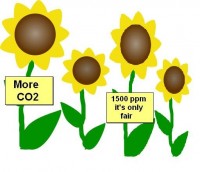
or seen in experiments here.
Greenhouses know this and actually many pump 3 times the ambient air CO2 into the greenhouses to produce a more vigorous plant growth, CO2 reaches levels up to 5 or 10 times higher in crowded auditoriums and malls, 30 times higher in submarines with no ill effect. CO2 is not a pollutant but an essential plant fertilizer. It has little or no effect on global temperatures. As both Singer and Broeker say, its all about water vapor and satellites and balloons say it is not increasing. The governments and environmentalists don’t talk about water vapor because there is no way to make money off of it. They can’t tax the hydrological cycle or prevent you or the soil and oceans from evaporating water vapor or trees transpiring it. They can and have tweaked their climate models to show water vapor increasing as CO2 increases, but as noted that is not the case. This is why their climate models despite their best efforts to manipulate temperatures to appear otherwise are failing miserably.
Patrick J. Michaels, George Mason University
Michael Mann’s Dec. 31 Letter to the Editor, “Science Journals Must be Unpolluted by Politics,” states that I falsely claimed that work by me and “other fossil-fuel-funded climate change contrarians” has been “unfairly blocked . . . from appearing in mainstream science journals.”
In fact, this started nearly 20 years ago, when Stephen Schneider, the editor of Climatic Change, rejected a manuscript of mine reconstructing upper-air data, saying that its “counter-paradigm” nature required that it be subject to more vigorous peer review than other submissions.
Prof. Mann claims that other “skeptics” (whatever that means), such as University of Alabama’s John Christy, have “no problem” with the mainstream journals. Prof. Christy recently documented a remarkable series of publication irregularities directed against him and other scientists, revealed in the climategate emails.
Recently, Roger Pielke Jr., director of the University of Colorado’s Center for Science and Technology Policy Research, noted a series of “effort[s] by activist climate scientists to stage-manage the peer review process much like how one might manage a partisan blog for public consumption.” One of his sources is again climategate, which is rife with threats to boycott a journal that dared to publish papers that Prof. Mann and his friends disagreed with.
In passing, I would note that the University of Virginia, where I worked for nearly 30 years, has rather rigorous standards for promoting scientists like myself through the academic ranks. Instead, Prof. Mann cites President Barack Obama’s science adviser John Holdren as an authority on my work, all the while arguing for keeping science “unpolluted by politics”!
Read more here.
---------------------------
Global Warming Meltdown
By KUSI’s John Coleman
Global Warming: Meltdown digs deeply into the strong differences of positions about global warming; It answers the negative responses by several key institutions to our first global warming telecast in January. See the special in 9 parts here.
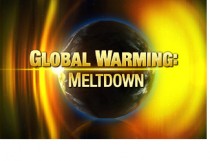
The “Climategate” revelations that began in mid December have crescendoed into a series of almost daily embarrassments for the UN IPCC. This telecast covers as many of them as we can cram into an hour. The program can be viewed in segments. With the intro to each segment you will find links you may use to find more information on the topics covered. If this is the first time you are hearing about my efforts to debunk the bad science behind the global warming frenzy, you will find a wealth of information, videos and links to sites on the colemanscorner page here.
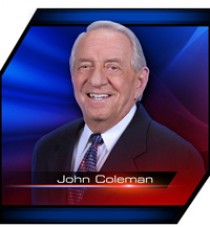
*The first program “Global Warming: The Other Side” can be viewed here. See the SPPI paper featured in it here.
--------------------------
The sound of alarm
By Dr. Richard Lindzen, MIT letter to Boston Globe
February 19, 2010
Kerry Emanuel’s February 15 Boston Globe op-ed ”Climate changes are proven fact” is more advocacy than assessment. Vague terms such as “consistent with,” “probably,” and “potentially” hardly change this. Certainly climate change is real; it occurs all the time. To claim that the little we’ve seen is larger than any change we “have been able to discern” for a thousand years is disingenuous. Panels of the National Academy of Sciences and Congress have concluded that the methods used to claim this cannot be used for more than 400 years, if at all. Even the head of the deservedly maligned Climatic Research Unit acknowledges that the medieval period may well have been warmer than the present.
The claim that everything other than models represents “mere opinion and speculation” is also peculiar. Despite their faults, models show that projections of significant warming depend critically on clouds and water vapor, and the physics of these processes can be observationally tested (the normal scientific approach); at this point, the models seem to be failing.
Finally, given a generation of environmental propaganda, a presidential science adviser (John Holdren) who has promoted alarm since the 1970s, and a government that proposes funding levels for climate research about 20 times the levels in 1991, courage seems hardly the appropriate description - at least for scientists supporting such alarm. See letter here.

Richard S. Lindzen
Cambridge
The writer is Alfred P. Sloan professor of atmospheric sciences at the Massachusetts Institute of Technology.
See his video interview for Copenhagen and John Coleman here.
By Dan Weil
New research from multiple scientists indicates the case for global warming isn’t as strong as some would have it.
The United Nations Intergovernmental Panel on Climate Change (IPCC) recently declared that “unequivocal” evidence shows human pollution is driving temperatures up.
It says the global temperature already has risen by 0.7 degree centigrade thanks to greenhouse gases. And it predicts another five to six degrees of extra heat by 2100, wreaking havoc on living things worldwide.
But many are now challenging that claim.
“The temperature records cannot be relied on as indicators of global change,” John Christy, professor of atmospheric science at the University of Alabama, Huntsville, a former lead author for the IPCC, told The Sunday Times of London.
He and others say weather stations that have been used to amass temperature data over the past 150 years may not be accurate. The stations have been affected by urbanization, changes in land use and in many instances moves to different locations.
Christy’s research examines the impact of those factors on three different regions: east Africa, California and Alabama.
“The story is the same for each one,” he said. “The popular data sets show a lot of warming but the apparent temperature rise was actually caused by local factors affecting the weather stations, such as land development.”
Ross McKitrick, professor of economics at the University of Guelph, Canada, agrees.
“We concluded, with overwhelming statistical significance, that the IPCC’s climate data are contaminated with surface effects from industrialization and data quality problems. These add up to a large warming bias,” he told The Sunday Times.
A new report by Joseph D’Aleo, a meteorologist who co-founded the Weather Channel, and veteran meteorologist Anthony Watts makes much the same points.
“Instrumental temperature data for the pre-satellite era (1850-1980) have been so widely, systemically and uni-directionally tampered with that it cannot be credibly asserted there has been any significant global warming in the 20th century,” they write.
“All terrestrial surface-temperature data bases exhibit very serious problems that render them useless for determining accurate long-term temperature trends.” Read more here.
--------------------------
IPCC Corruption Included Ignoring Facts and Science
By Dr. Tim Ball, Canada Free Press
Phil Jones, disgraced and dismissed Director of the Climatic Research Unit (CRU), granted BBC reporter Roger Harrabin an interview. Why Harrabin? His reporting has shown bias on all the IPCC and CRU activities. Leaked emails showed the CRU gang used friends in the BBC and that apparently continues. Prevarication, evasion, half-truths continue in Phil Jones’answers. Despite this there are stunning admissions from Jones. “There is a tendency in the IPCC reports to leave out inconvenient findings, especially in the part(s) most likely to be read by policy makers.”
It’s a deliberate strategy not just a tendency and not only in the Summary for Policymakers (SPM). Many major factors that create weather and can trigger change are ignored in the Scientific Report and computer models. Icecap Note: Tim then goes on in some detail to discuss one, the sun. He then concludes:
Watch the Richter Scale as Politicians Jump Off the IPCC Wagon
Jones only concedes some points but they are enough from the high priest of the CRU and IPCC to completely destroy its credibility. What will the sycophants and exploiters like Gore and the Mainstream Media do now? What about politicians who based positions and policy on environment and energy on the IPCC? What about the massive scams of Cap And Trade? What about the extreme environmental groups who have bullied and preached from the moral high ground? What about the scientists who took vehement positions without understanding? It is a very sad day for science, the people and the world. Read full post here.
-------------------------
Dalton Minimum Repeat goes mainstream
By David Archibald
The AGU Fall meeting has a session entitled “Aspects and consequences of an unusually deep and long solar minimum”. Two hours of video of this session can be accessed here.
Two of the papers presented had interesting observations with implications for climate. First of all Solanki came to the conclusion that the Sun is leaving its fifty to sixty year long grand maximum of the second half of the 20th century. He had said previously that the Sun was more active in the second half of the 20th century than in the previous 8,000 years. This is his last slide:
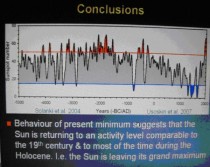
Enlarged here.
To get his papers published, Solanki has had genuflect to global warming. Perhaps he won’t have to do that from now on.
McCracken gave a paper with its title as per this slide:
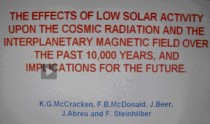
Enlarged here.
While he states that it is his opinion alone and not necessarily held by his co-authors, he comes to the conclusion that a repeat of the Dalton Minimum is the most likely thing to happen next:

Dalton Minimum Repeat goes mainstream. Enlarged here.
Solar Cycle 24 is now just over a year old and the next event on the solar calendar is the year of maximum, which the green corona brightness tells us will be in 2015.
A repeat of the Dalton Minimum will have consequences for the Earth’s climate. Just how cold will it have to get for the Thames to freeze over, as it last did in 1815? See PDF here.
----------------------
Stimulating Green Jobs For China
Investor’s Business Daily
When even Chuck Schumer is upset with the White House, you know something’s amiss. In this case, it’s news that efforts to boost wind power with taxpayer stimulus dollars are filling foreign coffers and creating foreign jobs.
According to the Investigative Reporting Workshop at American University, nearly $2 billion in money from the American Recovery and Investment Act has been spent on wind power. The goal was to further energy independence while creating American jobs. It has done neither.
Of the money spent, according to the report, nearly 80% has gone to foreign manufacturers of wind turbines.
“In all due respect, I remind (Energy Secretary Steven Chu) there is a four-letter word associated with the stimulus - J-O-B-S,” Sen. Schumer, D-N.Y., told ABC News, which interviewed him for a report done in coordination with the workshop’s investigation. “Very few jobs here, lots of jobs in China.”
The only good thing one can say is that at least China is a real place, as opposed to the phantom ZIP codes and congressional districts in which the administration has claimed to have created jobs.
But how does buying wind turbines made in China create energy independence or create jobs?
Last October, on the day the workshop first reported on this story, a consortium of U.S. and Chinese companies announced a deal to build a $1.5 billion wind farm in Texas, using imported Chinese turbines.
The project is expected to create some temporary construction jobs in America. Some 2,000 manufacturing jobs will be created in China. In a message posted on his Facebook page, Secretary Chu wrote that the point of the grant program was “ensuring America leads the world in creating jobs in manufacturing the parts that go into wind farms” and even export components to foreign wind farms. It hasn’t worked out that way.
Of the 1,807 turbines erected on 28 wind farms receiving grants, foreign-owned manufacturers built 1,219, according to the workshop report. The installation of these turbines may have created as many as 6,838 manufacturing jobs overseas.
When the American Wind Energy Association released its 2009 year-end report on Jan. 26, CEO Denise Bode acknowledged that despite billions in stimulus spending, there had actually been a net loss in manufacturing jobs. Bode told USA Today she estimates the manufacturing job loss at 1,500.
Last March, a cargo of steel towers was unloaded at the port of Vancouver, Wash. They were made in Vietnam for a Danish wind company and destined for a Portuguese wind farm in Indiana that got a stimulus grant. Posted 02/11/2010 05:50 PM ET
The towers arrived in Washington state after traveling 7,400 miles from Vietnam’s Barra VANUATU province, where they were constructed by CS Wind - Vietnam’s leading steel tower manufacturer.
We’re all for free trade, but stimulus money was supposed to create jobs in America. As for helping us achieve energy independence, wind has failed miserably.
After decades of subsidies, wind provides only 1% of our electricity compared with 49% for coal, 22% for natural gas, 19% for nuclear power and 7% for hydroelectric. Wind turbines generally operate at only 20% efficiency vs. 85% for coal, gas and nuclear plants.
The irony is we leave vast reserves of job-creating domestic oil, coal and natural gas locked up as we sacrifice our economy to the Gaia, the goddess of climate change, something China has wisely refused to do. Read story here.
Speaking of China:
Frozen Cattle Crisis In Harsh Mongolia Winter
Sky News
Up to 20 million farm animals may die in Mongolia before spring as the fiercest winter in living memory grips the country, International Aid Agencies are being warned. Half the entire country’s livestock could be wiped out, local experts told the Red Cross.
A Sky News team that travelled through remote regions in Central Mongolia found cattle, goats and sheep frozen to death across the plains, with some herds almost completely wiped out. Outside her traditional home in Central Mongolia, grandmother Hotont Suon weeps as she looks at the carcasses of her herd lying on their backs.

Their legs in the air, they are frozen to death. In the pens, sheep huddle together from the bitter cold. Two died while we watched. Dogs and goats gnaw from the carcasses of the dead animals strewn outside the traditional “gurs”, the herders’ circular tented homesteads.
“Our hay is all gone now. As our goats die we sell the hides and buy more fodder, but it only lasts a few days,” she said. It’s called the “Dzud” - a multiple disaster with a summer drought followed by one of the coldest winters on record. It has left millions of livestock dying from a combination of exhaustion and starvation - some herders report that their cattle perish at the rate of 50 a night.
Some families have even been reduced to sharing their small tented home with the surviving animals. Inside a gur, a three-month-old baby played with a black wet-faced calf. The baby’s mother, Otgon Jargal, broke down in tears. “We have no skills. Our lives depend on our livestock. How can I look after my child when all the animals have died?” she cried.
The Mongolian government has appealed for food, medicine and animal food to combat one of the country’s worst natural disasters. The poorer herding families are left with insufficient food supplies to last out the winter. Many have taken out high interest loans to pay for animal fodder which they can’t meet.
Fears are also growing for thousands of herders who live in remote mountain regions in soutwestern Mongolia. There has been no word from thousands of people cut off in their villages by the heaviest snow fall in decades, prompting Mongolian air force helicopters to launch search and rescue operations.
Read more here. See this shocking video here.
By Joseph D’Aleo
Update: Guest post by Steven Goddard on Watts Up with That
A 2005 Columbia University study titled “WILL CLIMATE CHANGE AFFECT SNOW COVER OVER NORTH AMERICA?” ran nine climate models used by the IPCC, and all nine predicted that North American winter snow cover would decline significantly, starting in about 1990.

See full post here.
UPDATE: Pittsburgh now has the snowiest February on record (since 1884) with 38.5 inches and the second snowiest month ever (behind the 40.2 in January 1978. In much of Montana, snowcover has been deep and longer lasting than any year in up to a quarter century.
A significant storm has brought heavy snows to Texas through the Gulf States to the southeast coast to Charleston, SC and even the FL Panhandle. Reports are that there was some snowcover in all 50 states for the first time ever recorded (or at least since the great cold outbreak of 1898/99). In actual fact, Hawaii, which normally has snow on its high volcanic peaks and did a few weeks ago, doesn’t at the moment although I would guess if you searched hard enough in the crevasses on the north facing slopes you might find some but even 49 states is quite a rare feat. The Joe Romm memorial winter continues to amaze.
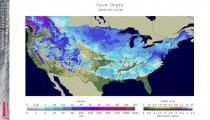
The amazing snowcover map for February 13, 2010 enlarged here.
NATIONAL WEATHER SERVICE FORT WORTH TX
410 AM CST FRI FEB 12 2010
...Snow Event One For The Record Books…
As of Midnight CST, DFW Airport had recorded 11.2 inches for the calendar day. This is the greatest calendar-day snowfall total on record for Dallas/Fort Worth. The previous record was 7.8 Inches on January 15, 1964 and January 14, 1917.
As of 4 AM...DFW Airport had recorded 12.5 Inches of snow in the prior 24 hours. This breaks the previous 24-Hour record for February...7.5 Inches On February 17, 1978 and February 25, 1924.
This brings the seasonal snowfall total To 15.7 Inches...which is the 2nd highest seasonal total on record for Dallas/Fort Worth behind just 1977-78. This is the snowiest winter in 32 seasons (since 1977-1978).
DALLAS/FORT WORTH - SNOWIEST SEASONS
1 17.6 1977-78
2 15.7 2009-10*
3 15.3 1963-64
4 13.5 1923-24
5 10.4 1976-77
6 9.5 1909-10
7 9.2 1916-17
8 8.8 1947-48
9 8.1 1937-38
10 7.3 1965-66 and 1941-42
As the storm moved east, 8 inches fell in parts of MS not far from Jackson, 7 inches fell at Cooks Crossroads in AL, 4 inches of snow fell in Atlanta, GA with up to 6 to the southeast, 4 inches fell at Athens, GA and even 2 in Macon, GA and 3 inches fell in Charleston, SC with up to 7 inland. 1 inch fell at Jay in the northwest FL Panhandle. In all, 1180 snow records were set.
See Snow Line is Moving SOuth by Steve Goddard on Watts Up With That here.
-----------------------
Watch here as Bill Nye the Science Guy says that these storms are consistent with global warming and its just us older folks that can’t grasp the idea that billions more people are inducing climate change while younger people (brainwashed by their schools) seem to grasp it better.
See “A Psychological Profiling of Global Warming” in Clamour of the Times where Philip Stott explain why some people can’t let go of global warming here.
-------------------------
Climate panel facing calls to restructure
By Eloise Gibson, NZ Herald
Breaking News: Scroll down to ICING THE HYPE to see how one member of the CRU investigative panel has resigned
Leading climate scientists from three countries have called for radical changes to the United Nations’ climate change panel as it faces intense scrutiny.
NZ experts say the Intergovernmental Panel on Climate Change (IPCC) should simply follow its own rules to avoid slips such as the 2007 error exaggerating the speed of glacier melt in the Himalayas.
But four of five climatologists who were asked to propose solutions in the international journal Nature suggested more radical options. The Nature article, released yesterday, asked: “IPCC: cherish it, tweak it or scrap it?”.
Mike Hulme, an IPCC lead author of the University of East Anglia in England, said the panel should be split after its 2014 report to part the physical scientists who observe and predict climate change from a separate policy analysis group. A third group would carry out regional assessments.
He wanted six-yearly assessments covering all aspects of climate change scrapped in favour of policy reports on options such as carbon border tariffs and ways to slow deforestation.
A separate group of physical scientists would write “smaller, sharply focused” updates on the science. Jeff Price, a lead author on the third and fourth IPCC reports, said the process was too slow: “A new class of short, rapidly prepared, peer-reviewed reports is needed.”
And Eduardo Zorita of the GKSS Research Centre in Germany said the IPCC should be replaced by an “International Climate Agency”, perhaps with 200 staff. He said the International Atomic Energy Agency, the European Central Bank or the US Congressional Budget Office showed it was possible to be independent and respected.
John Christy of the University of Alabama suggested turning the IPCC into “a living, Wikipedia-IPCC” open to published scientists, to be updated online and with sections overseen by groups of four to eight experts.
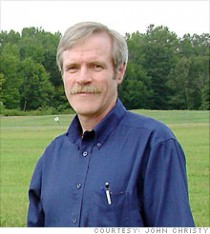
Several experts said a problem was that the IPCC produces its main reports only once every six years. The last was in 2007 drawing on the work of 2500 experts and totalling about 3000 pages.
But Thomas Stocker of the University of Bern, a co-chair of one of the IPCC's three main working groups, defended the panel's existing plans, saying reports every six years ensured "the robustness required for a thorough assessment".
He said the panel had fulfilled its role as an "honest broker" with "remarkable rigour and integrity".
New Zealand climate scientists agreed, saying that rather than "fixing" the panel its facilitators should be asking why the Himalayan glacier paper made its way into a report and how it was not picked up.
"It is ... clear that this mistake could have been avoided," said Victoria University climate researcher Andy Reisinger, "if all people involved in the process ... had meticulously followed the existing guidelines.
"Asking for wholesale revision to the IPCC in the wake of this mistake appears to be throwing out the baby with the bathwater, and dismantling the bath tub as well, when all it needed was a reminder to clean behind the ears."
An error that Himalayan glaciers could melt by 2035 - a huge exaggeration of the thaw - led to calls for reforms of the panel that shared the 2007 Nobel Peace Prize.
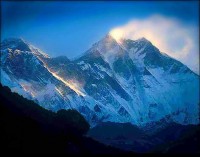
Read more here.
UPDATE: See Kirk Myers Seminole County Exnvironmental News Examiner column here on snowstorms and global warming.
By Joseph D’Aleo
MEDIA SPIN ZONE
Time Magazine tells us record Mid-Atlantic snows are consistent with or even resulting from global warming. The equally grumpy and empty headed reporters at MSNBC agreed.
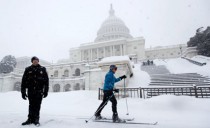
The last few years, they ignored the snow that set all-time records further north in much of western and southern Canada, Washington, Oregon, Colorado, Iowa, North Dakota, Wisconsin, Michigan, Vermont, New Hampshire and Maine and overseas in Europe, south China, Middle East, South America and New Zealand. But when it falls in the normally bare ground Mid-Atlantic and especially in the capitol where the politicians, environmental NGO and alternative energy lobby calls home, it can no longer be ignored (see story here). Especially on a day when NOAA had planned a press release on their new Climate Service, formed to help us deal with a warming world, which instead was done via a phone teleconference.
So to try and save their agenda, the green media and alarmists spin the tale that these storms are what you expect during global warming. Actually friends they conflict with statements from the IPCC and EPA Technical Support Document that drew on the NOAA CCSP.
EPA TSD ES3 “Rising temperatures have generally resulted in rain rather than snow in locations and seasons where climatological average (1961-1990) temperatures were close to 0C. (32F).”
IPCC FAQ 3.2 Observations show that changes are occurring in the amount, intensity, frequency and type of precipitation. More precipitation now falls as rain rather than snow in northern regions. For a future warmer climate, models project a 50 to 100% decline in the frequency of cold air outbreaks relative to the present in NH winters in most areas.
“The 2009 U.S. Climate Impacts Report found that large-scale cold-weather storm systems have gradually tracked to the north in the U.S. over the past 50 years.”
A DOSE OF REALITY
Preliminary all-time seasonal snowfall records were set at the three major climate sites in the Baltimore-Washington area...The Washington- Baltimore January average temperatures are near freezing (BWI 32.3F, DCA 34.9F, IAD 31.7F) with at lreast a month of winter to go.
In February in Dulles, the coldest spot, it averages 34.8. They are running 6.8F below normal so far not warmer. Dulles month-to-date has had 38.6 inches not including today. IAD was 0.8F below normal in December when the first snow came (35.2F vs. 36F average).
With the 10.8 inch two-day snowfall total measured at Ronald Reagan Washington National airport...the seasonal snowfall total in Washington DC stands at 55.9 inches. This would break the previous all-time seasonal snowfall record of 54.4 inches set in the winter of 1898-99. Official snowfall records for Washington DC date back 126 years to 1884. See chart of snow versus annual temperatures courtesy of Bruce Hall below described here and enlarged here.
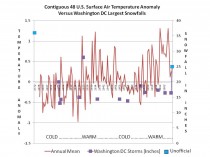
With the 19.5 inch two-day snowfall total measured at Baltimore/Washington International Thurgood Marshall airport...the seasonal snowfall total in Baltimore stands at 79.9 inches. This would break the previous all-time seasonal snowfall record for Baltimore of 62.5 inches set in the winter of 1995-96. Official snowfall records for Baltimore date back 118 years to 1893.
Finally, the two-day snowfall total at Dulles is 9.3 inches...which would make this years seasonal snowfall total 75.0 inches.. This would break the previous seasonal snowfall record of 61.9 inches set in 1995-96. Official snowfall records for Dulles date back 48 years to 1962.
In Philadelphia, 71.6 inches has fallen this year breaking the seasonal record of 65.5 inches. Atlantic City, NJ has had 49.9 breaking the record of 46.9 inches set in 1966-1967.
Though MUCH less snowy this year (note NYC Central Park has seen 25.5 inches and Boston’s Logan Airport 30.1 inches as of February 11), recent years have seen big time snows in cities further north even though like DC their temperatures are not far from the 32F level in their climatology.
New York City’s Central Park has a January (their coldest month) average temperature of 0.1C and winter average of 1.0C. For the first time since records began in the 1860s, Central Park reported four successive years of 40 inches of snow or more ending in the winter of 2005/06. On February 11-12, 2006, Central Park broke the all-time single snowstorm record with 26.9 inches of snow. Also in 1995/96, Central Park and most other cities in the central and eastern US had all-time record seasonal snowfall. In Central Park, that winter brought 76 inches of snow.
Boston, MA where the winter temperature averages -0.1C, the 12 year average snowfall in the winter ending 2004/05 was 51.3 inches, the highest in their entire record dating back into the 1800s. A new all-time single snowstorm record was set on February 17-18, 2003 with 27.6 inches and a new all-time seasonal snowfall record of 108 inches was set in 1995/96. Since 1992, Boston has recorded their 1st, 3rd, 5th, 7th and 12th snowiest winters.
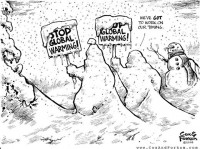
Enlarged here.
We are also told “The extent of NH snow cover has declined”. (IPCC4.2) They go on to say it will decline so much as to endanger the winter sports industry. Well two years ago, Michael Berry, President of the National Ski Areas Association told the AP that “This could very well be the record year”. Across almost all of North America, 2007/08 was the best, or one of the best seasons ever for those who enjoy winter sports. Practically every ski area from Alaska across Canada in the Western U.S. - the Midwest and New England saw plenty of snow; many places reporting all-time record snow.
And January in 2008, a new record for snowcover was set for the hemisphere.
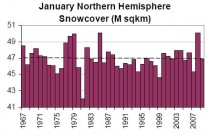
February is likely to set a new record or be among the top snowiest Februarys in the hemisphere. We were in 4th place in 5th week of the year (in 31 years) (below enlarged here).
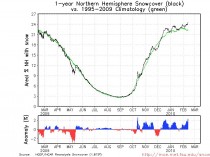
This is reminiscent of the day in January 2000, when NOAA’s NWS had a press conference to state that they had just made operational a super-computer that should ensure they never again would miss another major storm. The very next day a major nor’easter dumped heavy snow on all the eastern cities not forecast by their super computer and their models just 24 hour ahead. This heralded the Gore effect which is spreading.
By the way while the deal with mail box hiding snow in DC, Northern New England west to Michigan is seeing much below normal snows though it is cold. This is typical in El Ninos but the real driver for locking in the storm track so far south was the 5 standard deviation negative AO in December and again this month. This forces cold air to middle latitudes feeding cold air into the southern storm track especially as El Nino weakens.
BUT ALARMISTS HOLLER “WE PROMISED GLOBAL WARMING WOULD BRING STRONGER STORMS”
The 2009 U.S. Climate Impacts Report found that large-scale cold-weather storm systems have gradually tracked to the north in the U.S. over the past 50 years. This year we have had snow as far south as Miami and Naples Florida with snow possible Friday and again next week in the Gulf States down to the Florida panhandle. More Florida freezes are likely through early last week, where the January cold set records for duration and did serious damage to the citrus (worst freeze damage since 1989).
They also stated the warming would be greatest in higher latitudes. Actually that would decrease the contrast in temperatures north to south, which is what feeds the mid-latitude storms. They should grow weaker not stronger and with warming and the jet stream retreating north not south, global warming would not suggest snow to the Gulf of Mexico.
Cooling is what produces clouds and precipitation. The earth is cooling, the folks in the Mid-Atlantic and southeast will attest to that. No media spin to the contrary or data manipulation by NOAA, NASA can convince them otherwise. Read more here.
This letter was sent to NASA GISS’s James Hansen by Arvind Kumar after he noticed that the anomalies he had downloaded each year had changed with each new update.
Dear Dr. Hansen,
I see that the numbers in the data set here keep changing. I know that there were reports that you revised them once to make 1934 the hottest year on record and this was due to a bug. However, when I go to archive.org, I find that the numbers for specific years change arbitrarily and I have picked dates after you made the change. Perhaps it is not arbitrary, and maybe this is the famous “Mike’s Nature Trick” that everyone speaks of? Can you please explain why the numbers for the same year keeps changing?
Here are links and the data sets for 01/10/2006, 10/14/2007, 02/21/2008 and current date.
The numbers for the Annual Mean from the four links for many of the years are not constant but are as follows (enlarged here):
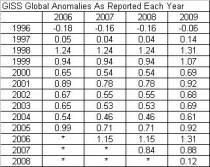
It is disturbing because it appears that the numbers are touched every year so that the claim of the current year being the “hottest on record” or the “second hottest on record” can be made. This would be consistent with, for example, 2005 when the number was first .99 but needed to be wound down to .71 the next year when the numbers for 2006 came out so that the 2006 number was significantly higher than the number for 2005. Subsequently, the 2005 number had to be increased in order to make the average for the decade higher.
Thanks,
Arvind
Arvind then documented the year to year changes here.
Well the answer came from E. M. Smith of the Musings from the Chiefio site:
“It is inherent to the way GIStemp runs that every month will produce a new and different history.
EACH and EVERY time the input data changes (by, for example, having a new month of data as time passes) will produce a different set of ‘homogenization’ adjustments and different UHI adjustments and GRID Box adjustments.
One example: All records shorter than 20 years are disposed. If a record is 19 years 11 months long, it is simply thrown away. In the next month, ti will be 20 years old, and so kept. Suddenly there are 20 years of history for this new record and just as suddenly it will be used to fill in missing data in other temperature series for the past 20 years. More perniciously, it will also participate in UHI adjustments that may extend to the beginning of time in the data set (it can help determine the adjustment factor during the period of overlap, that may then be applied in far removed times.)
So it is simply to be expected that history, in GIStemp, is a polite fiction that is re-written on each monthly computer run. So you can point this out to Hansen and friends and they will simply nod approvingly.”




